1980 Honda CX500 Custom Cafe’
 The Plastic Maggot. That is what the British and European press called the CX500, and deservedly so. I think, however, that bad styling got in the way of some great technology. Yes, the bike was patterned after the Moto Guzzi 500 v twin but Honda did some things to make it much better, Styling not included. Little things like twisting the cylinders so that carbs wouldn’t hit the riders knee’s. The CX500 really was and still is a really good motorcycle, hey, even police departments around the world loved these bikes.
The Plastic Maggot. That is what the British and European press called the CX500, and deservedly so. I think, however, that bad styling got in the way of some great technology. Yes, the bike was patterned after the Moto Guzzi 500 v twin but Honda did some things to make it much better, Styling not included. Little things like twisting the cylinders so that carbs wouldn’t hit the riders knee’s. The CX500 really was and still is a really good motorcycle, hey, even police departments around the world loved these bikes.
The CX500 was especially nice when cafe’d up.
I found a nice example on ebay this morning that looks like it would be a lot of fun to ride. The seller did some simple but nice upgrades, some minimalistic styling, which follows true cafe racer form, and made this bike ready to ride right now with nothing to do. Nice bike.
Click on the pics below for more pictures and more info. The other thing about CX500’s…they really sound good with a more flowing exhaust like this one has.
1985 Yamaha Virago Custom
 Now this is a custom that I can really love. Not for its looks but for its soul and the guy that built it. Take a slow, overweight, ill handling motorcycle and make it something cool.
Now this is a custom that I can really love. Not for its looks but for its soul and the guy that built it. Take a slow, overweight, ill handling motorcycle and make it something cool.
The Yamaha Virago line of bikes have never been all that great in any category, but they have always sold relatively well for the tuning fork company. I have, and still do, lust after an early ’80’s XV920RH model. It is the Euro styled Virago based ride that just works for me. The Yamaha V-Twins are good solid motors, no issues (for the most part) and have a good feel to them. Yamaha was the first of the Japanese companies to go after the factory cruiser market and were pretty successful at it. The tuning fork company made a lot of different versions of the Virago all the way down to a little 250cc model. To this day the Star brand still has a lot of the old Virago in it’s DNA.
So, back to this Virago I found on ebay today. This is a very unique custom…it truly is a hack build, and I mean that in a good way.
The owner worked on the frame, took it back to a twin shock design, popped in a Honda CBR900RR front fork and added some Kawasaki EX500 rear sets. All to make the bike handle better. Then comes the custom work. A handmade steel tank, and here’s the part I really dig… The guy made some headers himself and then went to the best supplier of cheap parts…JC Whitney for the mufflers. Man, I love this build. Take a pound mutt, don’t make it into a throughbred, just make it mean. Oh and I really love the tail light!!
Click on the pics below for more info and more pictures.
1976 Honda GL1000 ‘Bold wing’
 This is how most all of us look at Gold Wings…old guys riding the interstate with the onboard stereo blasting away and at the end of the day staying at the Holiday Inn. I know this from experience. My dad got back into motorcycling after about 30 plus years and his goal was to ride a Gold Wing. I started him on a CB350, then a CX500 Silver Wing and eventually a GL1100 Gold Wing. He didn’t use the stereo all that much but he did like the Holiday Inn.
This is how most all of us look at Gold Wings…old guys riding the interstate with the onboard stereo blasting away and at the end of the day staying at the Holiday Inn. I know this from experience. My dad got back into motorcycling after about 30 plus years and his goal was to ride a Gold Wing. I started him on a CB350, then a CX500 Silver Wing and eventually a GL1100 Gold Wing. He didn’t use the stereo all that much but he did like the Holiday Inn.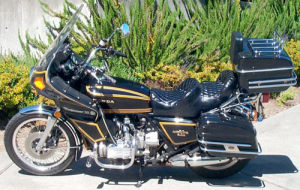
Me, I remember when the Gold Wing first arrived on the scene. I was living in Las Cruces New Mexico and the local Honda dealer had the Honda rep come out and show everybody the GL1000. What a boat…until you rode it. Yeah it weighed a lot, and yeah the steering was kinda slow but when you got it up to speed, this thing worked!
Because of its low center of gravity the GL series of Honda’s handle really well, add to that the torque of the motor and you have a bike that is ripe for going fast. All it needs is a bit of suspension work. Instead of cushy go for sporty. Honda originally brought out the ‘Wing’ as a sport bike not a tourer. Craig Vetter made a tourer out of the GL not Honda.
So, over the years many ‘Wing’ riders figured out the true purpose of the GL and made some great cafe racers out of the big four. I found a really nice one on ebay today. A few modifications, nothing serious, but nicely set up. The bike has only 38K miles on it, which in ‘Gold Wing’ miles is barely broken in. This is a really nice motorcycle. If any of you out there think a first generation Gold Wing is just an old mans highway cruiser,think again…these bikes can fly., hence the name.
For info and more pictures, click on the pics below.
1972 Honda CB350 Custom
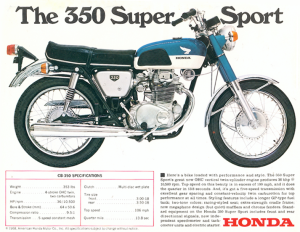 Here we have a very nicely sorted but not over done Honda. Styling wise it is a very clean Cafe Racer, mechanically I’m guessing it’s still pretty much stock save the pod filters and the tidy exhaust. This is the pattern I am going to use for my own 350 project.
Here we have a very nicely sorted but not over done Honda. Styling wise it is a very clean Cafe Racer, mechanically I’m guessing it’s still pretty much stock save the pod filters and the tidy exhaust. This is the pattern I am going to use for my own 350 project.
The owner obviously went through the process of dismantling the bike, cleaning, painting and polishing, then went into cafe mode. First stop, Benji’s Cafe Racers for the body work. I believe the ‘El Poquito’ body is absolutely the best looking for the CB. Clean additions like the Air-tech front fender, the polished clip-ons and some nice rearsets take care of the styling and functionality. I also like the silver paint, simple and elegant.
A good cafe racer has to handle well and this bike seems to be on its way to that goal. The shocks are far better than the stockers but what did he do with the front? Upgraded springs? even an oil change? There are some simple frame mods that make a huge difference on CB’s. Looks like the bike has stock wheels with a couple decent tires spooned on.
All in all, this is probably the nicest CB350 I have seen. Good looking, better handling, reliable and so much fun to ride!! This guy (or gal?) has put a lot of time, love and money into this Honda and it shows. And with the low miles it has on the clock (provided it is the real mileage), it will be fun to ride for years and will draw a crowd wherever you go. For more info and more pictures, click on the pics below.
1977 Harley Davidson XLCR
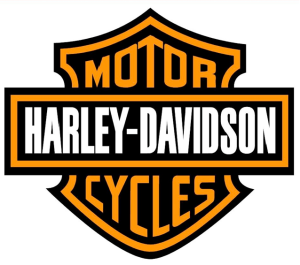 I made the mistake once of telling a potential employer (my local Harley Davidson dealer) that the only Harley I really liked was the XLCR from the late 70’s. The minute that sentence came out of my mouth I knew I was not going to be wearing orange and black to work each day. I did my best to backtrack but by then I was being shown the door. Oh well. Ironically, today I do ride a Buell, which is powered by Harley Davidson.
I made the mistake once of telling a potential employer (my local Harley Davidson dealer) that the only Harley I really liked was the XLCR from the late 70’s. The minute that sentence came out of my mouth I knew I was not going to be wearing orange and black to work each day. I did my best to backtrack but by then I was being shown the door. Oh well. Ironically, today I do ride a Buell, which is powered by Harley Davidson.
It is true though that I really like the XLCR, it is some sort of mental deficiency I understand that, but there is just something about that bike that works for me. The XLCR was the first bike designed by Willie G. himself and marketing wise it went over like a fart in church. To the faithful it was the bastard stepchild. The Cafe racer had more going against it than for it right from the get go. One, it didn’t look like a Harley should look. Two, it was made during the AMF period and it’s pretty common knowledge that those were as close to junk as could possibly be. Unreliable, poor fit and finish, and just shoddy in general. Fortunately, that period didn’t last too long and The Motor Company came back strong.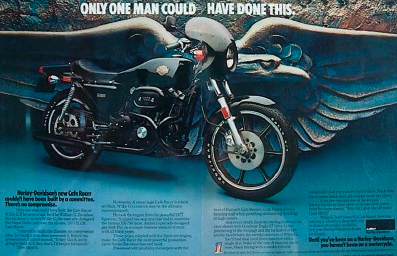
In 1977 The Motor Company built a few less 2,000 XLCR’s, 1978 had a production of around 1,000 and the last year, 1979, of the Cafe Racer there were only 9. Back then you could own one for just $3595…actually many were sold for a lot less. Today, a nicely kept or restored original goes for over $10,000!
I found one today on ebay that has a few modifications and is showing its age, but that’s OK. The mods include upgraded rear shocks, a new carb (sans air cleaner), and a what looks to be a loud exhaust. The bike needs some love but not too much from what I can see and might be had for a somewhat reasonable price.
XLCR’s have a very definite cool factor, and it still one of only a couple Harley’s I would like to own.
Click on the pictures below for more pics and more info.
1978 Yamaha XS400
 Yeah, I know that most of you (me too) like bigger bore bikes to convert to the style we like, Cafe’. But…smaller bikes are so much fun to ride, and…embarassing riders on modern 1000cc bikes through tight twisty roads, well, that just makes the ride all that much more fun.
Yeah, I know that most of you (me too) like bigger bore bikes to convert to the style we like, Cafe’. But…smaller bikes are so much fun to ride, and…embarassing riders on modern 1000cc bikes through tight twisty roads, well, that just makes the ride all that much more fun.
Building small, 100cc-400cc bikes is a lot of fun. Parts are generally easily acquired, they don’t require high levels of mechanical skills, and like I said before, riding small bikes is a sh*tload of fun.
I found an almost done little Yamaha XS400 on ebay this morning that would make a great weekend canyon blaster or as it is, a good daily commuter. The XS400 is as reliable as the sun coming up each morning, loves to rev to the limit (and then some), has a chassis that is very capable of embarrassing bigger bikes in the twisties (with just a couple of easy suspension mods) and, they are cheap and easy to maintain…unlike your ex-girlfriend.
This XS I found has only 2700 miles on the clock, it is a kickstart only model, which is actually a good thing, has a nice set of wire wheels instead of the mags that came with most XS models and a nice paint job. Two things I would do here…get rid of the ugly tail light, put something that fits into the seat cowling, and change the exhaust. The straight exhaust doesn’t help the motor and a little 400cc twin sounds terrible with straight pipes. A nice reverse megaphone muffler would look great, sound better and make the motor run happier. This is a nice bike and the price doesn’t seem all that unreasonable for how few miles it has on it. I would still go through the carbs, do some suspension upgrades, put a proper set of clip-ons or clubman bars, and then go have a lot of fun.
Click on the pics below for more pictures and info.
1996 Harley Sportster Cafe’
 Recently I spent some time with my friend Erik doing a heart transplant on his Sportster. Erik rides hard, he spends more time on the rev-limiter than most people spend on their bikes. But, Erik takes care of his bikes, well, kind of? After 70,000+ miles of abuse his Sporty decided it was done. A good used motor was found on ebay, shipped to California and without too much drama installed.
Recently I spent some time with my friend Erik doing a heart transplant on his Sportster. Erik rides hard, he spends more time on the rev-limiter than most people spend on their bikes. But, Erik takes care of his bikes, well, kind of? After 70,000+ miles of abuse his Sporty decided it was done. A good used motor was found on ebay, shipped to California and without too much drama installed.
Erik has been, little by little, turning his Sportster into a Cafe Racer. Suspension mods,clip-ons, exhaust, seat…it’s all coming together nicely but I know he wants to do more.
Erik is considering new wire spoked wheels, new bodywork and pumping up the motor. It’s going to be a really well put together bike when done. But…I found one on ebay today that is already done and looks to me to a perfect example of how a Sportser should look.
I have to digress here a bit though, I have never been a fan of Harley Davidsons, except one…the XLCR, Harley’s (more exactly Willie G. Davidson’s) first design out of the cruiser/touring market. This has to probably be thee most underloved Harley ever built. It may be powered by a Harley motor but to ‘The Faithful’ it wasn’t a Harley Davidson. The XLCR fit into the same category as the little 2 strokes from Italy…maybe even lower. However, the XLCR has become a cult bike and quite valuable.
Today, Sportster based Cafe Racer’s aren’t all that unusual. The first one I ever saw was at one of my semi-regular Sunday stops ‘The Rock Store’ in the Santa Monica Mountains. The license plate on this particular Sporty was ‘DUCHUNTER’ and that was the owners favorite game, chasing down Ducati’s in the canyons. He often won the game.
The ’96 I found today is beautiful. Bodywork is a beautifully shaped 4 gallon tank, a classic Ducati seat and tail section, a sweet looking exhaust, nice clip-ons and classic aluminum spoked wheels. Everything about this bike looks to have been done with a a lot of love and attention to detail. This is how I hope Erik’s turns out but with his own special touches.
For more info and pictures, click on the pics below. And now, I’m going to go out and ride my own Harley powered Buell over to Erik’s and work on his Sporty Cafe Racer.
1967 Bultaco Metralla Mk2
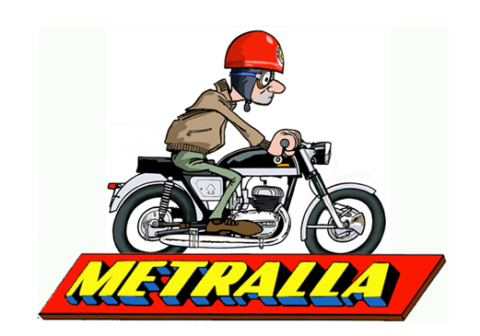 Picture this, you’re buzzing along a tight twisty mountain road on a classic roadracer that just happens to have lights and a horn. The bike is light, quick and amazingly agile. The bike almost knows what you’re going to do before you do. A very light push on the bars sends you through the corner apex at speeds that put larger bikes to shame. The skinny little tyres turn in with no effort yet keep you right on line. You my friend are riding a Bultaco Metralla and your destination is wonderful little Spanish restaurant and plate of the best Paella in Northern Spain.
Picture this, you’re buzzing along a tight twisty mountain road on a classic roadracer that just happens to have lights and a horn. The bike is light, quick and amazingly agile. The bike almost knows what you’re going to do before you do. A very light push on the bars sends you through the corner apex at speeds that put larger bikes to shame. The skinny little tyres turn in with no effort yet keep you right on line. You my friend are riding a Bultaco Metralla and your destination is wonderful little Spanish restaurant and plate of the best Paella in Northern Spain.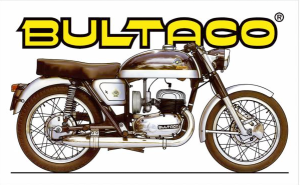
Ok, the reality is you’re not in Spain and you’re not going to have Paella, you’re going to have a chili and cheese omelet at the Rock Store on Mulholland Highway in the Santa Monica Mountains and you’re going to have to answer a hundred questions from guys that have never even heard of Bultaco about your little Metralla. These are the guys you blew by in the corners. This is the definition of a really fun Sunday morning.
 I love Bultaco’s, always have. I started racing a Bultaco Matador back in 1968, moved up to Pursangs, rode an Astro in a couple of TT races but never owned a Metralla. While I was helped in my desert racing and enduro career by the local Bultaco dealer, they never let me take out the street bikes, probably a smart move on their part at the time. Would I want another Bultaco dirt bike now? probably not. Would I want a Metralla today? Oh Yeah! This is the perfect example of Spanish art on two wheels.
I love Bultaco’s, always have. I started racing a Bultaco Matador back in 1968, moved up to Pursangs, rode an Astro in a couple of TT races but never owned a Metralla. While I was helped in my desert racing and enduro career by the local Bultaco dealer, they never let me take out the street bikes, probably a smart move on their part at the time. Would I want another Bultaco dirt bike now? probably not. Would I want a Metralla today? Oh Yeah! This is the perfect example of Spanish art on two wheels.
A few years back while on my way from a vintage roadrace at Willow Springs to another one at Sears Point in Northern California I stopped in Minden Nevada to get some Bultaco spiritual guidance (and a couple of parts for a Sherpa T I had inherited), from the Bultaco Guru of the West, Lynn Mobley. Guru Lynn had just finished a full restoration of a ‘67 Metralla and let me ride it around his property for a bit, I had to have the Metralla. I offered up both my roadracers and ‘The Mighty 350’ in trade for the little Bultaco, and while Lynn did everything he could to keep from laughing, I could see that the Metralla was not going home with me.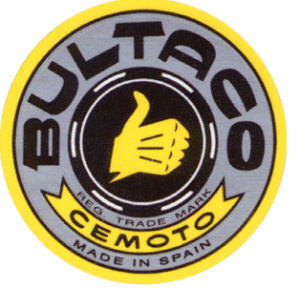
So, today I found a really beautiful Metralla on ebay that is ready to ride right now. It’s a 1967 Mk2 that has been restored to pretty much stock condition, there are a few little tweaks here and there but the original parts that were changed out will come with the bike. It really is a beautiful motorbike and if you would like something will always put a huge smile on your face consider this Metralla. This is a no-brainer. Click on the pics below for more information and more pictures.
And one last little thing…the Metralla was the first 250cc bike that straight from the factory would top 100mph! How cool is that?!
1969 BSA A65 Road Racer
 In 1969 BSA commanded 80% of all the Brit bikes sold here in the USA. Eighty Percent! Who woulda thunk? I, and I think most of us, would have pegged Triumph as the leader but not so say the statistics. What was it about BSA that made it that strong a seller in a time when the Japanese manufacturers were dominating the market? Was it styling? No. Was it performance? No. Was it reliability? Certainly not. So what was it?
In 1969 BSA commanded 80% of all the Brit bikes sold here in the USA. Eighty Percent! Who woulda thunk? I, and I think most of us, would have pegged Triumph as the leader but not so say the statistics. What was it about BSA that made it that strong a seller in a time when the Japanese manufacturers were dominating the market? Was it styling? No. Was it performance? No. Was it reliability? Certainly not. So what was it?
 Let’s find a bit of perspective here. BSA may have had 80% of the British bike sales here in the states but ‘Made in England’ motorcycles constituted a very small percentage of the total bikes sold here. So small that within a decade, they were all gone from the US market.
Let’s find a bit of perspective here. BSA may have had 80% of the British bike sales here in the states but ‘Made in England’ motorcycles constituted a very small percentage of the total bikes sold here. So small that within a decade, they were all gone from the US market.
From the late 1950’s through the mid 60’s, the British were competing with the very popular Harley Davidson Sportster in the performance category. The Sportster was Harley’s ‘sportbike’, it had a slight horsepower advantage, it had a new look (the peanut tank was quite stylish then), it had the Harley sound and, of course, it had the advantage of being made in the USA. BSA, Triumph and Norton all were better handling motorcycles but back then, straight line speed was king, not the ability to go around corners fast.
Each of the big three from the UK tried styling mods to attract the American market, Triumph with the X75 Hurricane, Norton tried (and miserably failed) with their Hi-Rider chopper model and BSA tried with…well, nothing. Sure, BSA tried a few styling changes like a smaller slimmer tank, the oil in the frame design (which nobody was really happy about), and of course the ray-gun mufflers of the Rocket 3. Personally, I love the ray-gun mufflers but at the time they went over like a fart in church. Anyway, the Brits just faded away into the sunset. Today, Triumph is back in a big way and Norton is getting set to comeback this year with a new Commando and it is beautiful. I hope it succeeds.
I started my street bike life aboard a BSA so the brand has a certain spot in my heart that will never go away. Yes, it stranded me more than once with faulty electric’s, and yes, it leaked more oil in a month than any Japanese bike I’ve ever owned did in a lifetime. It could be a bit (?) temperamental when it came to starting in the morning (or when it was hot and the bike didn’t feel like going anywhere), and it could vibrate the fillings out of my teeth if the carbs weren’t balanced properly, but…when everything was working as it was supposed to, what a joy it was to ride that Beezer. I was raised to ride the canyon roads, to believe in handling over horsepower, and the sound coming from a parallel twin was the sweetest sound in motorcycling.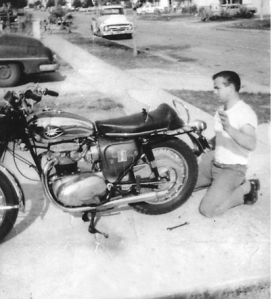
At one point in time (actually a couple of times) the Japanese manufactures realized that there was something about the British bikes that still captivated the American buyer. Yamaha did great with the XS650, designed to compete with the Triumph, Kawasaki brought out the W650 to head to head with the BSA and Honda tried with the GB500 single. The only one that succeeded over the long run was the Yamaha. Today, the Triumph Bonneville is a huge success because it looks like a proper English motorbike without the oil puddle underneath it.
Lately I have been thinning the herd of bikes in my barn and am starting to look for a new adventure…once I have finished the other four projects I have going, and am being drawn towards a BSA 650. I’m actually looking for one of the last designs more than the old chrome tank styles, mainly because I think they are probably going to be cheaper on the market(?). Today on ebay I found one that might just fit the bill.
On ebay today, there is a 1969 BSA A65 that has been set up for vintage roadracing. Remember, the A65 was BSA’s ‘roadracer for the street’. The A65 put out a very respectable 54HP and would top out at around 105MPH. This particular bike has been upgraded with Marzocchi forks, more modern rear shocks, and a Suzuki twin leading shoe front brake, which was a very good upgrade from the standard brake the BSA had at the time. The motor has been given some extra muscle by way of a 750cc kit But, here is the cool thing about this bike, it can easily be retrofitted with the electric’s to power a headlight, taillight and blinkers so you have a perfect cafe racer with almost no effort! The seller says that it does need some carb work but that’s no big deal. This could be a very sweet Sunday rider.
Click on the pics below for more pictures and more info.
 Leave a Comment
Leave a Comment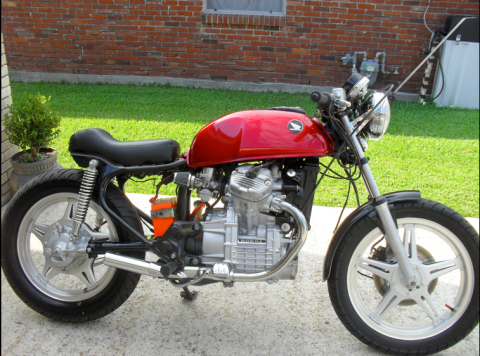

 1980 Honda CX500 Custom
1980 Honda CX500 Custom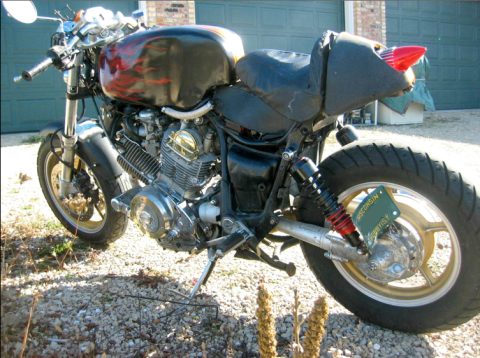

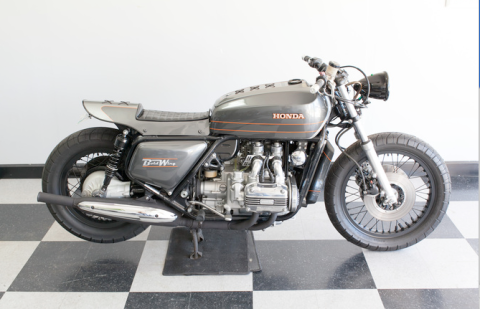

 1976 Honda Gl1000
1976 Honda Gl1000
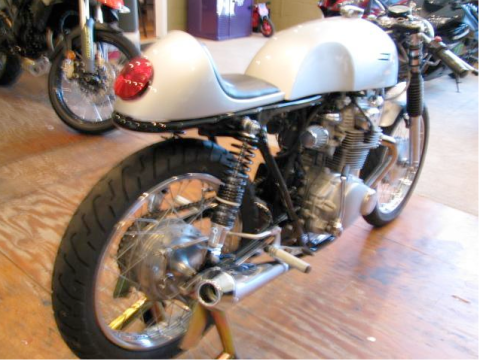
 1972 Honda CB350 Custom
1972 Honda CB350 Custom
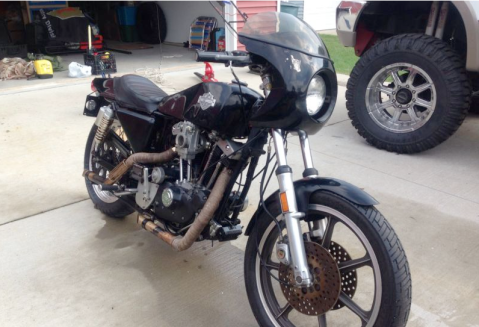
 1977 Harley Davidson XLCR
1977 Harley Davidson XLCR
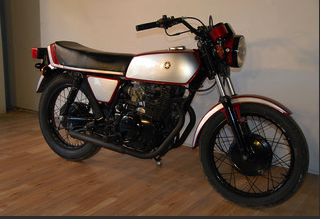
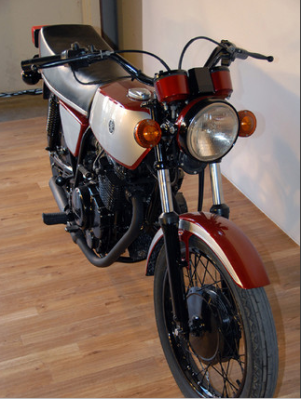 1978 Yamaha XS400
1978 Yamaha XS400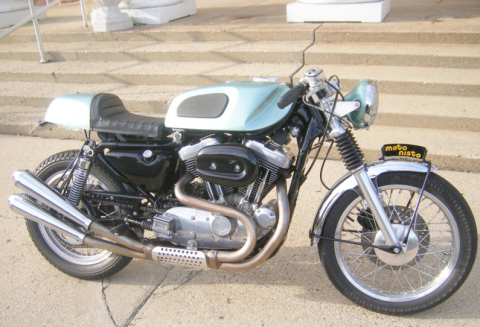

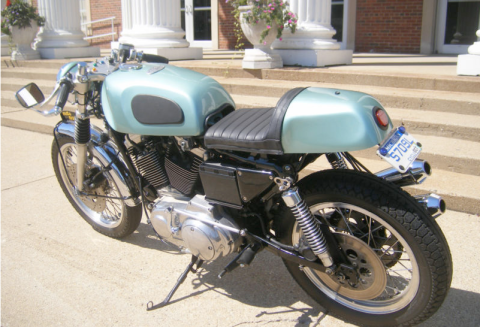 1996 Sportster Cafe Racer
1996 Sportster Cafe Racer

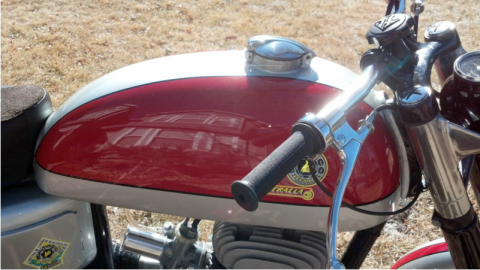
 1967 Bultaco Metralla
1967 Bultaco Metralla

 1969 BSA A65 Racer
1969 BSA A65 Racer
1973 Honda CL350 Cafe Racer
Filed under: Bikes, Commentary, eBay, Parts, Projects, Toys | Tags: 1973, cafe racer, cb350, eBay, exhaust, honda, honda cl350, motorcycle, project, racer
My love affair with the Honda twin began in 1971 when I was in a ‘one-upmanship’ contest with my friend Eddie. Even though I was riding a BSA 650 most of the time, the contest revolved around smaller bikes. Eddie won a couple of times but when I got my first SL350, his ‘little’ Yamaha DT1 250 was left in the dust…literally.
I eventually sold the SL350, after I had slogged it through the deserts of Southern California for a couple of years only to regret it a few years later. So…the search was on for another. I ended up with a 1972 CB350 that had been sitting out in a back yard for something like 10 years or so. That little 350 looked pretty bad, but it was all there and the price was right, a hundred bucks. On to my trailer it went (flat tires and all the spiders you could want, plus a dead mouse in the right side airfilter) and home it came with me. I still have it…25 years later.
Once home, some basic service, a lot of elbow grease and a few (?) new parts and I was back on my favorite little Honda twin. Over the years I put a mild cafe treatment on the bike, lower bars, changed the exhaust, moved the pegs back a bit, upgraded the suspension, I even put good tires on it. Now it is waiting for the big bore kit I recently acquired to be installed.
Building Cafe Racer out of a Honda 350 nowadays is a pretty easy thing to do. Parts are available easily; tanks, seats, controls,suspension, you name it and with a good credit card you can have it delivered to your door the next day. But here is the thing about building a vintage cafe racer,if you’re going to do it right, it ain’t gonna be cheap and it ain’t going to happen over a weekend. The time,effort and money you put into it is for your own pleasure…when time comes to sell it, don’t set your hopes too high.
So, on that note, I found a super sweet CL350 that has a whole lot of nice parts and a lot of love put into it and is being sold at a reasonable price (so far). This CL motor has been gone through, it didn’t need much it only has 4837 miles on it, carbs rebuilt, new electrics, etc, etc. Then we get into the really cool stuff.
The bike was stripped down and everything was either powder coated, painted or polished. The wheels got new spokes, bearings and tires. Suspension was all redone front and rear, nice handlebars, rearsets and the exhaust, which may be a bit loud but it sure looks good. I really dig the instruments and the headlight arrangement. I think I’m changing the vision I have for my own new 350 project.
This is a really nicely done Honda 350 that will last for a long time both mechanically and styling. Click on the pics below for more info and more pictures.
Oh and one last thing, the Honda advert says top speed is 100mph…don’t believe them…maybe 95mph is where it tops out. But with a very little work, the little 350 will ‘Do the Ton’. Have fun.